-

人教版高中英语必修3The million pound bank note说课稿3篇
在接下来的细读环节,我套用了高考对阅读理解的考查方式设置了5个问题,分别为三个推理判断题,一个细节题和一个主旨大意题。学生需要对文章的内容进行分析、归纳、推理、猜测等高级思维活动才能做出正确的回答。【设计意图】这一过程是对学生进行细读的训练,培养学生获取特定信息和挖掘文章深层次信息的能力。第三环节:Intensive-reading (精读) 15′第三个环节精读,既是最重要的环节,也是突破本课重难点的关键。首先,让学生思考剧本中人物看到百万英镑前后的态度发生了怎样的变化。其次,让学生仔细阅读文章,找出可以表现人物态度变化的具体的语言和动作。最后,让学生总结人物的态度发生变化的根本原因是什么,从而引出Money Talks, 供学生思考。【设计意图】通过一系列的活动培养学生学习从人物的语言和动作探究人物的心理,使学生进一步体会戏剧语言的魅力,从而对文章背后所反映的社会问题进行思考,也为下一步的讨论环节做好铺垫。

人教版高中英语必修5Great scientists说课稿4篇
通过写文章梗概,培养学生综合运用语言的能力,学习用恰当的英语描述科学家的故事。这是本课的教学难点。教师可以使用完形填空的方式来帮助学生整理语篇,从而来降低难度。本课的教学重点的突破方法是:在阅读前,让学生初步了解得出科学观点所需要的基本程序,从而轻松而自然地导入文章的阅读;在阅读过程中,由易到难设计快速阅读和精读的问题,层层推进各种阅读活动,让学生对阅读内容从整体感知到细节理解,最后深层读懂整篇文章,同时加强阅读策略的指导,让每个学生都主动参与课堂教学活动,最终达到提高阅读能力的目的。Step 4 Post-readingGroup Activities四人小组共同合作,在老师的适当指导下,就以下2个问题展开讨论,让学生就所知、所学、所感和所想融入话题,然后抽若干同学代表作小组发言。1. What do you think about John Snow, and what should we learn from him?2. Cholera was 19th century disease, which two diseases are similar to cholera today? Why?

人教版高中英语必修5Life in the Future说课稿5篇
Good afternoon, everyone. It’s my great pleasure to be here sharing my lesson with you. The content of my lesson is Senior English for China Book5 Unit 3 Life in the Future. I’ll be ready to begin this lesson from six parts: Analysis of the teaching material, Analysis of the students, Teaching aims and important and difficult points, Teaching methods and aids, Teaching procedures, and Blackboard design. First, let me talk about the teaching material.Part 1 Analysis of the Teaching Material:This unit is about what human beings’ life will be like in about one thousand years. By studying of this unit, we’ll Enable the students to know the changes in humans’ life and some new inventions bringing about the change and develop the interest in science. This lesson plays an important part in the English teaching in this unit. This is an important lesson in Book Five. From this lesson, it starts asking the Ss to grasp contents of each passage. Therefore, this lesson is in the important position of the teaching material. If the Ss can learn it well, it will be helpful to make the Ss learn the rest of this unit.Part 2 Analysis of the SsAs Senior2 Ss, they are at different levels of English fluency, some of them have lost interest in English. So during the lesson, I arrange a variety of activities to let all of them join in to attract their interest and let them be confident and taste the joy of success.

人教版高中英语必修5The United Kingdom说课稿4篇
Teaching Aims:Knowledge 1. Get the students to learn the useful new words and expressions in this section. Aims:2. Let the students learn about how the UK was formed and the four groups of invaders.1. Develop students’ reading ability and let them learn different Ability reading skills. Aims:2. Enable students to learn to talk about the United Kingdom and the Union Jack Emotional 1. Let students know more about the UK2. Develop students’ sense of cooperative learning Aims:Teaching Important Points:1. Let the students learn about the countries of the United Kingdom and the Union Jack2. Get the students to read the passage and know about how the UK was formed and the four groups of invaders.3. Have the students learn different reading skills.Teaching Difficult Ponts:1. Develop students’ reading ability.2. Enable students to talk about the United Kingdom and the Union Jack.3. Let students learn how the UK was formed geographically and historically.Teaching Methods:Showing pictures, asking, exercising, listening, reading etc.Teaching Aids:A computer,a projector and a blackboard.Teaching Procedures: 1) Show a map of the world, ask students the following questions:Where is the UK?What’s the full name of the UK?2) Ask the students work in pairs to do the quiz on Page 9.Do you want to test how many things you know about the United Kingdom? Let’s have a small test.Using the map on P9, students answer the following questions:?How many countries does the UK consist of? What are they??England is divided into three main areas. Do you know what they are? 1) Scanning (10Minutes )Let the students hold the questions asked in pre-reading and read the passagequickly and then let them do the following exercise.Join lines to the right answer.

人教版高中英语必修2Cultural Relics说课稿2篇
Ⅲ. Analysis of the teaching material:The topic of this unit is cultural relics. Students are quite interested in topics about different cultures around the world. This is the second period of the whole unit. As a reading class, the passage mainly talks about the history of the amber room (how it was made, sent as a gift, lost and rebuilt).According to the new national curriculum, when teaching reading, much emphasis should be put on training the students’ reading skills.Ⅳ. Teaching objectives1. Language objectives:1) Students are required to master the key words and phrases occurred in the passage (e.g. amazing, decorate, belong, in return, less than etc.)2) Students are required to learn the attributive clause and acquire the sentence pattern.2. 1) Students are required to describe a certain thing by using the new sentence patterns.2) Students are required to master two kinds of reading skills—skimming and scanning, and learn to use them in their daily reading.3. 1) Students are required to know the history of the amber room.2) Students are required to appreciate cultural relics and understand the importance of protecting them.Ⅴ. Teaching important and difficult points1) the new words, phrases, and sentence pattern in the course of reading.2) Teaching difficult point: Help the students master two kinds of reading skills—skimmingand scanning and learn to apply them in daily use.Ⅵ. Teaching methods:Task-based method & Top-down model Ⅶ. Teaching aids: PPT, pictures, blackboard Ⅷ. Teaching procedure:

人教版高中英语必修2Wildlife Protection说课稿3篇
When it comes to the students’ studying methods, I'd like to introduce my Ss first. The Ss have a good command of basic language points. They’re interested in learning English, and they take an active part in English class, so they will have fun in autonomous, cooperative and inquiry learning. I will just serve as a guide, showing them the way to explore how to make more progress in their English learning.Now it’s time for the most important stage of this lesson. My teaching procedures are arranged as follows:Step1.Leading-in (3 minute)Play a video of a wide variety of wildlife to introduce my topic. Step2. Speaking (12 minutes)We will use our textbook Page25. Let the Ss fast read the short paragraph to warm up. Ask them to talk about the report on some endangered wildlife in China with the dialogue patterns on the screen. Lastly, I will invite some groups to demonstrate their dialogues about saving wildlife in China.Step3.English play (3 minutes)Watch another video in praise of their excellent performance just now. It’s about Jack Chen’s(成龙)and Yang Ziqiong’s wildlife protection.Step4. Listening (twice 13 minutes)This time, I’ll ask the Ss to fill in the blanks of the monologue of the 2 movie stars above. Step5.Discussion (3 minutes)Which would you like to choose to wear, clothes made of cotton, artificial leather or animal skins? Why ?Step6. Summary (3 minutes)1. If there were no wildlife, there wouldn’t exist human beings. If the buying stops, the killing can, too.2. Animals are our friends. To love animals is to love ourselves. Stop hunting, killing and destroying wildlife.3. Let’s live in harmony with all the living things in the world. Step7. Music appreciation (3 minutes)Let the Ss appreciate the song Earth Song by Michael Jackson. Last but not the least, I will show you my blackboard design.

人教版高中英语必修4Women of achievement说课稿4篇
Good morning, distinguished judges:It’s my honor to talk about my teaching ideas with you. Today my topic is Women of Achievement. My presentation consists of six parts: the analysis of teaching material and student, teaching aims, key and difficult points, teaching and studying method, teaching procedures and blackboard design.First, let’s focus on the analysis of teaching material. This lesson is from New Senior English for China Student’s Book 4 Unit 1, the reading part. The main topic of the passage is the introduction of a student of Africanwildlife. After this lesson, the students will learn more information about her studying chimps in Africa, and their reading and speaking abilities can be developed as well.The next part is the analysis of students. My students are in senior high students. They have learnt English for many years, they’ve known many words and sentences, but their speaking and reading abilities are still not very good. So I will practice their speaking and reading abilities through different exercises.According to the New Standard Curriculum and the present situation, I set the teaching aims as follows: firstly, knowledge aims. Students can grasp some new words, such as worthwhile, move off. Moreover, students can understand the content of the passage and get familiar with the topic of studying chimps in wildlife. Secondly, ability aims. Students can use reading strategies such as skimming and scanning in reading process. Thirdly, emotional aims. Students can have the awareness of protecting animals and care about animals.Based on the above analysis, the key point of this lesson is to get the main idea and the detailed information from the passage; the difficult point is to talk about the wildlife protection and use reading strategies.

人教版高中英语必修3Healthy Eating说课稿4篇
Language learning needs a context, which can help the learners to understand the language and then can product comprehensible output, so computer has the advantages to make the materials attractive.Part 3 Learning MethodsTask-based, self-dependent and cooperative learningPart 4 Teaching ProcedureStep One Lead-in“Interest is the best teacher.” Therefore, at the very beginning of the class, I should spark the students’ mind to focus on the centre topic “the band”. I’ll show some pictures of food to attract their attention and then bring some questions.Question:What kind of food they like?What should go into a good meal?The answers must relate to the diet. After this, the students will be eager to know something about a balance diet and this is the very time to naturally lead the class into Step 2Step 2 Reading for information: skimming and scanning In this step, I use Task-based Language Teaching method, which can give students a clear and specific purpose while skimming and scanning the context.Task 1 General ideaThe students will be asked to just glance at the title and the pictures of the passage, and then guess what they will read in the text. And they’ll be divided into groups of four to have a discussion.The purpose is to inspire the students to read actively, not passively. In addition, the task is to develop the students’ reading skill by making prediction and to encourage the students to express their thoughts in English and cooperate with each other.Task 2 Main idea of each paragraphCooperative learning can raise the students’ interest and create an atmosphere of achievement. Based on this theory, I divide the whole class into 4 groups to skim the whole text and get the main idea of each paragraph.

人教版高中英语必修5First aid说课稿6篇
In this class, I have 3 teaching aims, that is, knowledge aims, ability aims and emotion aims.1) Knowledge-Teach students new words and expressions, such as temporary, bleed,sprain choke, first aid, fall ill and so on.-Enable students to have a better understanding for some basic knowledge of first aid.2) Ability-Train students’ speaking, reading and writing abilities by different teaching activities, such as skimming, comprehending, team work, role play, retelling and writing.-Develop students’ reading strategy on how to move general idea to specific information.3) Emotion-Promote students’ awareness of giving first aid.- Cultivate students’ creativities.Then let’s come to my teaching methods and activities.III. Teaching methods and activities:To achieve different teaching aims, various kinds of teaching methods and activities will be adopted throughout this period, such as TBL (task-based learning), skimming, team work, brainstorm and others, which can offer students opportunities to fulfill tasks in which they can use language to achieve a specific outcome.IV. Teaching aids:Computer and blackboardV. Teaching important points:1) Make students have a clear mind for the structure of the text.2) Help students understand the theme of the text.VI. Teaching difficulties:1) So many new words may affect students’ understanding.2) How to get students to know about the functions of the skin and thecauses, characteristics and treatments for different degree burns,and the knowledge about giving first aid. VII. Blackboard design:

人教版高中英语必修5Making the news说课稿4篇
今天我们来介绍一下必修五第四单元的授课方式。这个单元的题目是Making the news。应该是学生比较感兴趣的话题,学生往往对新闻工作充满好奇,所以我们可以利用这个机会多设计一些师生互动和学生互动,来激发起学习的积极性,提高学习效率。同时我们可以利用这个单元不仅帮助学生掌握语言知识,培养语言能力,同时让其了解新闻工作的重要性,培养起社会智能感。这个单元分为六个课时,它的教学目标是这样的:语言目标是掌握词汇表中的常用单词和短语,掌握倒装句的一些基本用法。 技能目标是能初步掌握约会的基本句型并在真实的场景下正确运用。新闻报道类文章的写作技能。采访的基本规范和沟通技能。情感目标是对新闻报道的客观性和真实性有更好的理解。对新闻记者的职业有更深入的了解,并能体会其工作的重要性。下面我们来介绍一下第一课时的授课方式,第一课的教学目标是这样的第一课时的教学目标语言目标:单词:Occupation, journalist, editor, photographer, curious, personality, enthusiasm
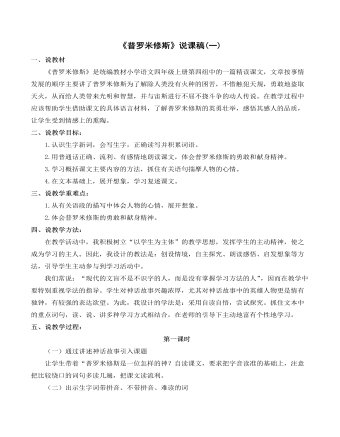
(新)部编人教版四年级上册《普罗米修斯》说课稿(一)
四、说教学方法: 在教学活动中,我积极树立“以学生为主体”的教学思想,发挥学生的主动精神,使之成为学习的主人。因此,我设计的教法是:创设情境,自主探究、朗读感悟、启发想象等方法,引导学生主动参与到学习活动中。 我们常说:“现代的文盲不是不识字的人,而是没有掌握学习方法的人”,因而在教学中要特别重视学法的指导。学生对神话故事兴趣浓厚,尤其对神话故事中的英雄人物更是情有独钟,有较强的表达欲望。为此,我设计的学法是:采用自读自悟,尝试探究。抓住文本中的重点词句,读、说、讲多种学习方式相结合,在老师的引导下主动地富有个性地学习。
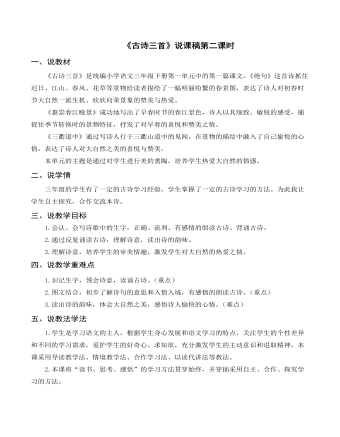
(说课稿)部编人教版三年级下册《古诗三首(二)》
一、说教材《古诗三首》是统编小学语文三年级下册第一单元中的第一篇课文。《绝句》这首诗抓住迟日、江山、春风、花草等景物给读者描绘了一幅明丽纷繁的春景图,表达了诗人对初春时节大自然一派生机、欣欣向荣景象的赞美与热爱。 《惠崇春江晚景》成功地写出了早春时节的春江景色,诗人以其细致、敏锐的感受,捕捉住季节转换时的景物特征,抒发了对早春的喜悦和赞美之情。 《三衢道中》通过写诗人行于三衢山道中的见闻,在景物的描绘中融入了自己愉悦的心情,表达了诗人对大自然之美的喜悦与赞美。本单元的主题是通过对学生进行美的熏陶,培养学生热爱大自然的情感。二、说学情 三年级的学生有了一定的古诗学习经验,学生掌握了一定的古诗学习的方法。为此我让学生自主探究,合作交流本诗。
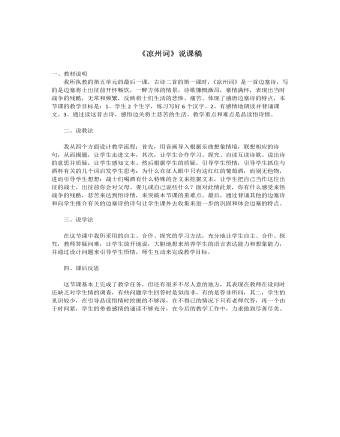
(新)部编人教版四年级上册《古诗三首》说课稿(二)
一、教材说明我所执教的第五单元的最后一课,古诗二首的第一课时,《凉州词》是一首边塞诗,写的是边塞将士出征前开怀畅饮,一醉方体的情景,诗歌慷慨激昂,豪情满怀,表现出当时战争的残酷,无常和频繁,反映将士们生活的悲惨、痛苦。体现了盛唐边塞诗的特点,本节课的教学目标是:1、学生2个生字,练习写好6个汉字。2、有感情地朗读并背诵课文。3、通过读这首古诗,感悟边关将士悲苦的生活。教学重点和难点是品读悟诗情。
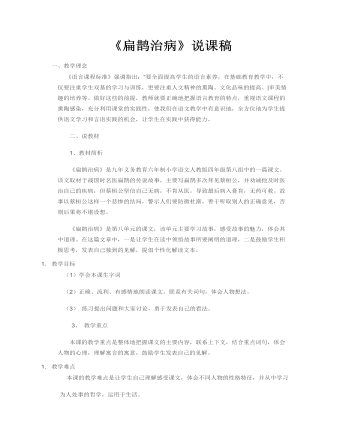
(新)部编人教版四年级上册《故事二则》说课稿(二)
一、教学理念《语言课程标准》强调指出:“要全面提高学生的语言素养,在基础教育教学中,不仅要注重学生双基的学习与训练,更要注重人文精神的熏陶、文化品味的提高、|审美情趣的培养等。做好这些的前提,教师就要正确地把握语言教育的特点,重视语文课程的熏陶感染,充分利用课堂的实践性,使我们在语文教学中有意识地,全方位地为学生提供语文学习和言语实践的机会,让学生在实践中获得能力。二、说教材1、教材简析《扁鹊治病》是九年义务教育六年制小学语文人教版四年级第八组中的一篇课文。该文取材于战国时名医扁鹊的传说故事,主要写扁鹊多次拜见蔡桓公,并劝诫他及时医治自己的疾病,但蔡桓公坚信自己无病,不肯从医,导致最后病入膏肓,无药可救。故事以蔡桓公这样一个悲惨的结局,警示人们要防微杜渐,善于听取别人的正确意见,否则后果将不堪设想。
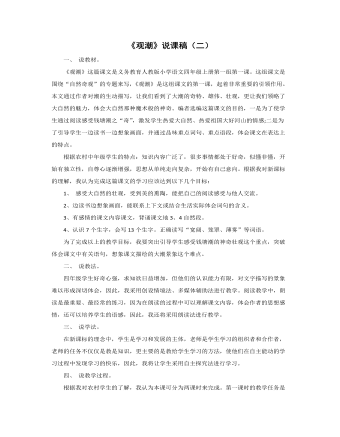
(新)部编人教版四年级上册 《观潮》说课稿(二)
一、 说教材。《观潮》这篇课文是义务教育人教版小学语文四年级上册第一组第一课。这组课文是围绕“自然奇观”的专题来写,《观潮》是这组课文的第一课,起着非常重要的引领作用。本文通过作者对潮的生动描写,让我们看到了大潮的奇特、雄伟、壮观,更让我们领略了大自然的魅力,体会大自然那种魔术般的神奇。编者选编这篇课文的目的,一是为了使学生通过阅读感受钱塘潮之“奇”,激发学生热爱大自然、热爱祖国大好河山的情感;二是为了引导学生一边读书一边想象画面,并通过品味重点词句、重点语段,体会课文在表达上的特点。根据农村中年级学生的特点:知识内容广泛了,很多事情都处于好奇,似懂非懂,开始有独立性,自尊心逐渐增强,思想从单纯走向复杂,开始有自己意向。根据我对新课标的理解,我认为完成这篇课文的学习应该达到以下几个目标:1、 感受大自然的壮观,受到美的熏陶,能把自己的阅读感受与他人交流。2、边读书边想象画面,能联系上下文或结合生活实际体会词句的含义。3、有感情的课文内容课文,背诵课文地3、4自然段。4、认识7个生字,会写13个生字。正确读写“宽阔、笼罩、薄雾”等词语。为了完成以上的教学目标,我要突出引导学生感受钱塘潮的神奇壮观这个重点,突破体会课文中有关语句,想象课文描绘的大潮景象这个难点。
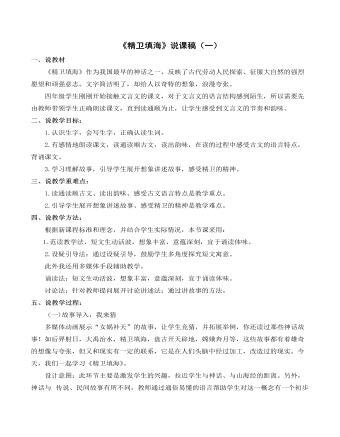
(新)部编人教版四年级上册《精卫填海》说课稿(一)
四、说教学方法: 根据新课程标准和理念,并结合学生实际情况,本节课采用: 1.范读教学法,短文生动活波,想象丰富,意蕴深刻,宜于诵读体味。2.设疑引导法:通过设疑引导,鼓励学生多角度探究短文寓意。此外我还用多媒体手段辅助教学。诵读法:短文生动活波,想象丰富,意蕴深刻,宜于诵读体味。讨论法:针对教师提问展开讨论讲述法:通过讲故事的方法。五、说教学过程:(一)故事导入,我来猜多媒体动画展示“女娲补天”的故事,让学生竞猜,并拓展举例,你还读过那些神话故事!如后羿射日,大禹治水,精卫填海,盘古开天辟地,嫦娥奔月等,这些故事都有着雄奇的想像与夸张,但又和现实有一定的联系,它是在人们头脑中经过加工,改造过的现实。今天,我们一起学习《精卫填海》。 设计意图:此环节主要是激发学生的兴趣,拉近学生与神话、与山海经的距离。另外,神话与 传说、民间故事有所不同,教师通过通俗易懂的语言帮助学生对这一概念有一个初步的认识,再自然引出课题。
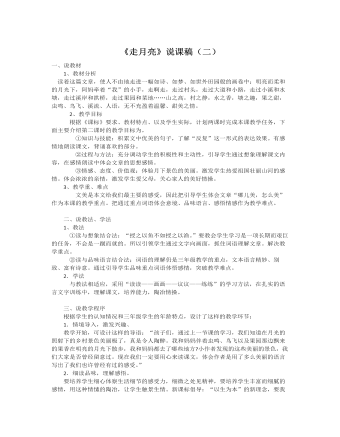
(新)部编人教版四年级上册 《走月亮》说课稿(二)
一、说教材1、教材分析读着这篇文章,使人不由地走进一幅如诗、如梦、如世外田园般的画卷中:明亮而柔和的月光下,阿妈牵着“我”的小手,走啊走,走过村头,走过大道和小路,走过小溪和水塘,走过溪岸和拱桥,走过果园和菜地……山之高,村之静,水之香,塘之趣,果之甜,虫鸣、鸟飞、溪流、人语,无不充盈着温馨、甜美之情。2、教学目标根据《课标》要求、教材特点、以及学生实际,计划两课时完成本课教学任务,下面主要介绍第二课时的教学目标为。①知识与技能:积累文中优美的句子,了解“反复”这一形式的表达效果。有感情地朗读课文,背诵喜欢的部分。②过程与方法:充分调动学生的积极性和主动性,引导学生通过想象理解课文内容,在感情朗读中体会文章的思想感情。③情感、态度、价值观:体验月下景色的美丽。激发学生热爱祖国壮丽山河的感情。体会浓浓的亲情,激发学生爱父母,关心家人的美好情操。
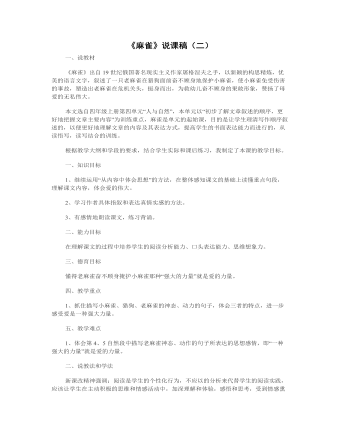
(新)部编人教版四年级上册《 麻雀》说课稿(二)
一、知识目标1、继续运用“从内容中体会思想”的方法,在整体感知课文的基础上读懂重点句段,理解课文内容,体会爱的伟大。2、学习作者具体指叙和表达真情实感的方法。3、有感情地朗读课文,练习背诵。二、能力目标在理解课文的过程中培养学生的阅读分析能力、口头表达能力、思维想象力。三、德育目标懂得老麻雀奋不顾身掩护小麻雀那种“强大的力量”就是爱的力量。四、教学重点1、抓住描写小麻雀、猎狗、老麻雀的神态、动力的句子,体会三者的特点,进一步感受爱是一种强大力量。五、教学难点1、体会第4、5自然段中描写老麻雀神态、动作的句子所表达的思想感情,即“一种强大的力量”就是爱的力量。
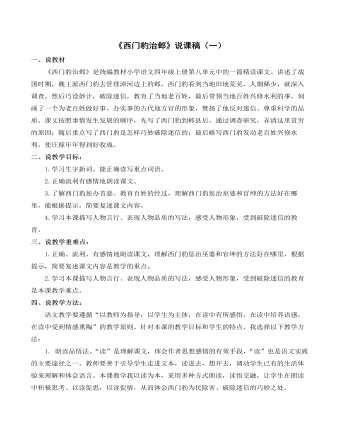
(新)部编人教版四年级上册《西门豹治邺》说课稿(一)
五、说教学过程:(一)课题导入。 以故事发生的背景导入,激发学生的阅读兴趣。 板书课题时,自然地指导生字“豹”的书写,加深学生的印象。(二)初读感知。 给学生充足的时间自主探究,让他们自由朗读课文,要求:读准字音,读通课文,遇到生字较多或难读的地方多读几遍。 我再利用多媒体检查自学情况。课件出示生字词检查认读,抽查朗读。对易读错、写错的字让学生交流讨论识字方法,帮助识记。对难读的句子,交流朗读方法和要点,学生进行展示读。 引导性提问:西门豹来到邺县,做了几件事?哪几件事?让学生整体感知文章内容。 以西门豹做的三件事为线索,让学生理清文章脉络,分清层次,概括内容。为后面对课文的复述做铺垫。
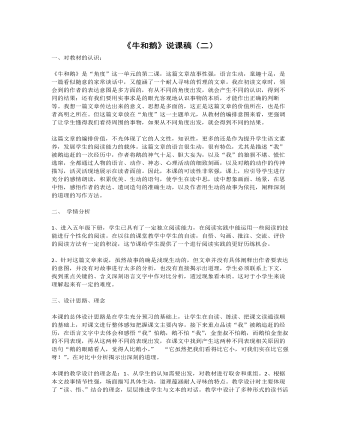
(新)部编人教版四年级上册《 牛和鹅》说课稿(二)
这篇文章的编排价值,不光体现了它的人文性,知识性,更多的还是作为提升学生语文素养,发展学生的阅读能力的载体。这篇文章的语言很生动,很有特色,尤其是描述“我”被鹅追赶的一次经历中,作者将鹅的神气十足、胆大妄为,以及“我”的狼狈不堪、慌忙逃窜,全都通过人物的语言、动作、神态、心理活动的细致刻画,以及对鹅的动作的传神描写,活灵活现地展示在读者面前。因此,本课的可读性非常强,课上,应引导学生进行充分的感情朗读,积累优美、生动的语句,使学生在读中思,读中想象画面、场景,在思中悟,感悟作者的表达、遣词造句的准确生动,以及作者用生动的故事为依托,阐释深刻的道理的写作方法。二、 学情分析1、进入五年级下册,学生已具有了一定独立阅读能力,在阅读实践中能运用一些阅读的技能进行个性化的阅读。在以往的课堂教学中学生的自读,自悟、勾画、批注、交流、评价的阅读方法有一定的积淀,这节课给学生提供了一个进行阅读实践的更好历练机会。2、针对这篇文章来说,虽然故事的确是浅现生动的,但文章并没有具体阐释出作者要表达的意图,并没有对故事进行太多的分析,也没有直接揭示出道理,学生必须联系上下文,找到重点关键的、含义深刻语言文字中作对比分析,透过现象看本质。这对于小学生来说理解起来有一定的难度。